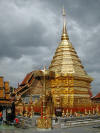|
Wat Doi Suthep (วัดดอยสุเทพ)
Thai. Temple in North Thailand, built at a height of 1,053 meters on the hill of
Doi Suthep, 14
kms to
the West of the city of
Chiang Mai. This very popular temple
is named after Sudeva, the Pali name of a hermit who lived on the mountain prior
to the construction of the temple and which translates into Thai as Suthep. The
temple has a staircase of 306 steps with
naga handrails
(map - fig.) and offers a panoramic view of the city (fig.). According to legend the
temple was built on the location where a
White Elephant which transported relics of the Buddha (fig.), circled three times and then died.
These relics had been discovered by the Ceylonese monk Sumanathera in
Sri Satchanalai as he traveled frequently between this city and
Sukhothai to spread
Theravada Buddhism. It was told the relic performed a miracle upon its discovery by
starting to glow. King Dhammaracha of Sukhothai asked for the relic, but when he
saw it and it didn't perform any miracle, he told Sumanathera
to keep it. Later when King
Keua Nah
(fig.) ruled over the northern kingdom of
Lan Na he invited Sumanathera to Chiang Mai. The latter left for Chiang Mai in 1369
bringing the relic with him and the king went out to welcome him, meeting the
monk as far out as
Lamphun.
Because the monk liked the place so much he stayed there for two years, in Wat
Phra Yeun. In 1371, he then moved to Wat Suan Dok
(fig.),
a temple-monastery in Chiang Mai specially built for himself and the
relic. The monk was highly respected
by the king who bestowed him the title of Phra Maha Sumana Suwan Rattana Bupah Maha Swami (พระมหาสุมนสุวรรณรัตนบุปผามหาสวามี), a
high ranking ecclesiastical title. When it was discussed to built a new pagoda
to house the relic, it was discovered that the relic had been miraculously split
in two, with one part being of the same size as the original relic. The smaller
relic was subsequently enshrined in a newly completed pagoda in Wat Suan Dok,
where it remains today; the other half of the relic was put on the back of an
auspicious White Elephant that carried it out through the city's Hua Viang Gate,
which was later renamed Pratu Chang Peuak or White Elephant Gate. The elephant
climbed the hills to the West of the city and Wat Doi Suthep
was built on the exact spot where the elephant circled three times
and died. A statue of the
elephant stands at the temple's entrance and
the golden
chedi of Wat Doi Suthep is currently depicted on 50
satang coins (fig.).
In 1935, the highly respected former abbot of Wat Ban Pang in
Lamphun,
Kruh Bah
Sri Wichai
(fig.) had the first motor road to the
temple built by his followers, who saw in him (fig.) a
bodhisattva. The temple's full name is Wat Phrathat Doi Suthep Raja
Worawihaan.
See POSTAGE STAMPS (1),
(2),
(3)
and
(4), TRAVEL PICTURE,
QUADCOPTER PICTURES (1),
(2)
and
(3), MAP,
and WATCH VIDEO.
回






|

